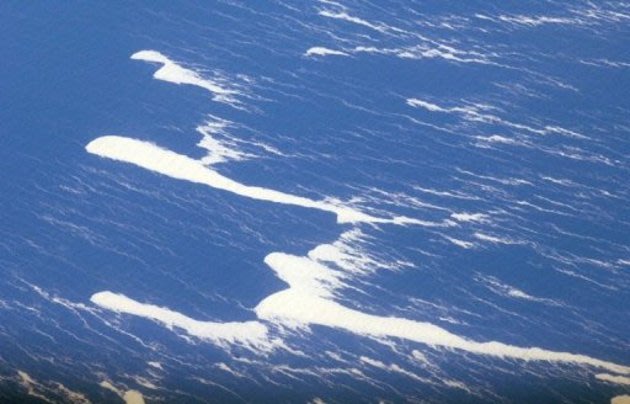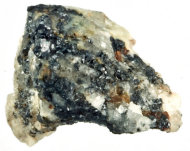Bizarre rock 'ice shelf' found in Pacific
From Yahoo News:
A huge cluster of floating volcanic rocks covering almost 26,000 square kilometres (10,000 square miles) has been found drifting in the Pacific, the New Zealand navy said Friday.
A huge cluster of floating volcanic rocks covering almost 26,000 square kilometres (10,000 square miles) has been found drifting in the Pacific, the New Zealand navy said Friday.
The strange phenomenon, which witnesses said resembled a polar ice shelf, was made up of lightweight pumice expelled from an underwater volcano, the navy said.
An air force plane spotted the rocks on Thursday about 1,000 kilometres (600 miles) offshore from New Zealand and warned a navy warship that it was heading towards them.
Lieutenant Tim Oscar said that while he knew his ship the HMNZS Canterbury was in no danger from the pumice, which is solidified lava filled with air bubbles, it was still "the weirdest thing I've seen in 18 years at sea".
"As far ahead as I could observe was a raft of pumice moving up and down with the swell," he said.
"The rock looked to be sitting two foot (half a metre) above the surface of the waves and lit up a brilliant while colour in the spotlight. It looked exactly like the edge of an ice shelf."
Scientists aboard the ship said the pumice probably came from an underwater volcano called Monowai, which has been active recently.
They said the phenomenon was unrelated to increased volcanic activity in New Zealand this week, including an eruption at Mount Tongariro that sent an ash cloud 20,000 feet into the atmosphere.
Extraterrestrial Origin: Bizarre Crystal Zipped Here From Outer Space:
A sample of a bizarre crystal once considered unnatural may have arrived on Earth 15,000 years ago, having hitched a ride on a meteorite, a new study suggests.
The research strengthens the evidence that this strange "quasicrystal" is extraterrestrial in origin.
The pattern of atoms in a quasicrystal falls short of the perfectly regular arrangement found in crystals. Until
January, all known quasicrystals were man-made. "Many thought it had to be that way, because they thought quasicrystals are too delicate, too prone to crystallization, to form naturally," study researcher Paul Steinhardt of Princeton University told LiveScience at the time.
January, all known quasicrystals were man-made. "Many thought it had to be that way, because they thought quasicrystals are too delicate, too prone to crystallization, to form naturally," study researcher Paul Steinhardt of Princeton University told LiveScience at the time.
Then researchers announced the presence of a natural quasicrystal in a meteorite found in the Koryak Mountains of Russia. . That meteorite was being kept in a museum in Italy. Now, on an expedition to the site where it was found in Russia, Steinhardt and his colleagues now have found more natural samples of quasicrystals for analysis.
Mysterious matter
Quasicrystals were first synthesized in a lab in 1982 by Israeli chemist Dan Shechtman, whose work won the Nobel Prize for Chemistry in 2011. Regular crystals are made up of regular clusters of repeating atoms arranged in particular symmetries. Quasicrystals are orderly, too, but they do not exactly repeat themselves. If regular crystals are like boring bathroom tiles, quasicrystals are like complex tile mosaics.
Steinhardt and his colleagues were long on the hunt for natural quasicrystals. They first saw one in 2008, when Italian mineralogist Luca Bindi of the Museum of Natural History in Florence spotted a tiny quasicrystal grain in a rock sample in the museum's collection.
The researchers reported that find in the journal Science in 2009 and then traced the rock to Russia. An analysis of the rock fragment, published in January in the journal Proceedings of the National Academy of Sciences, concluded that the rock was a meteorite that likely formed in the early solar system more than 4.5 billion years ago, before the Earth existed.
The hunt for quasicrystals
Now Steinhardt and Bindi report in the journal Reports on Progress in Physics that quasicrystal samples are found in an environment that would not have had the extremes needed to create them. The report strengthens the case that the sample rode to Earth on a meteorite.
On their expedition to the Koryak Mountains, the researchers also determined that the samples came to Earth during the last glacial period, about 15,000 years ago.
"The fact that the expedition found more material in the same location that we had spent years to track down is a tremendous confirmation of the whole story, which is significant since the meteorite is of great interest because of its extraordinary age and contents," Steinhardt said in a statement.
The next goal, Steinhardt said, is to figure out the secret of the natural quasicrystals' formation.
"What does nature know that we don't?" he said. "How did the quasicrystal form so perfectly inside a complex meteorite when we normally have to work hard in the laboratory to get anything as perfect? What other new phases can we find in this meteorite, and what can they tell us about the early solar system?"
"At the moment, we are at the tip of the iceberg," Steinhardt added.
Cool but rather somewhat odd news for this early in August :) - Rob


No comments:
Post a Comment